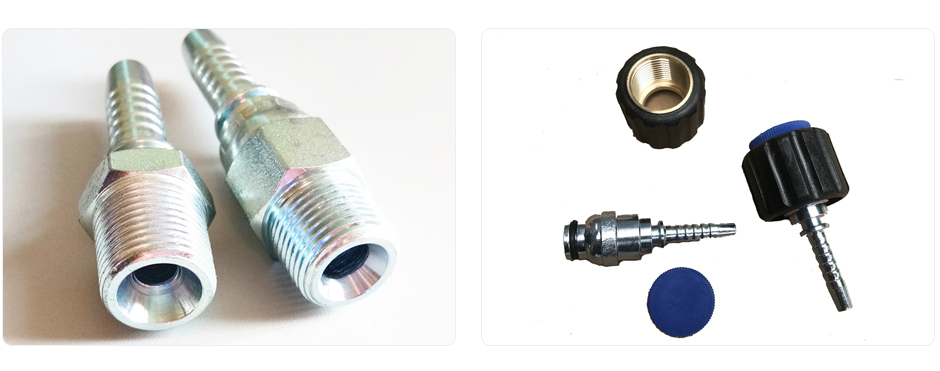335345435
Dez . 02, 2024 04:01 Back to list
Production of High-Quality PTFE Hoses for Enhanced Performance and Durability
Understanding Production Processes for PTFE Hoses
Polytetrafluoroethylene (PTFE) hoses are a critical component in various industries due to their remarkable properties such as chemical resistance, high-temperature tolerance, and low friction. As the demand for PTFE hoses continues to rise, understanding the production process becomes essential for both manufacturers and end-users. This article delves into the intricacies of PTFE hose production, highlighting key processes, quality control measures, and applications.
The Composition and Properties of PTFE
PTFE, a fluoropolymer, is renowned for its unique characteristics. It is non-reactive, making it ideal for transporting aggressive chemicals. Additionally, its ability to withstand temperatures ranging from -200°C to 260°C (−328°F to 500°F) without degrading makes it suitable for high-temperature applications. PTFE hoses can also resist UV radiation, making them durable in outdoor settings. These properties ensure that PTFE hoses meet the demands of various industries, including pharmaceuticals, food and beverage, and oil and gas.
Production Process of PTFE Hoses
The production of PTFE hoses involves several critical steps
1. Preparation of PTFE Resin The first step in production is acquiring high-quality PTFE resin. This polymer is typically produced using a polymerization process involving gaseous tetrafluoroethylene (TFE) under controlled conditions. Once synthesized, the resin is processed into fine powder.
2. Extrusion The PTFE powder is then mixed with a lubricant, which aids in the extrusion process. The mixture is fed into an extruder, where it is heated and forced through a die to form a hose shape. The extruded PTFE material is cooled down and solidified.
3. Sintering After extrusion, the PTFE hose undergoes a sintering process. This involves heating the hose at controlled temperatures to enhance its strength, elasticity, and overall physical properties. Sintering allows the individual particles of PTFE to fuse together, creating a dense and robust structure.
production ptfe hose

4. Reinforcement Many applications require hoses to withstand high pressure and external impacts. As a result, PTFE hoses are often reinforced with materials like stainless steel wire or fiberglass. This reinforcement improves the durability and pressure resistance of the hose, allowing it to perform efficiently in challenging environments.
5. Cutting and Finishing After reinforcement, the hoses are cut to specific lengths based on customer requirements. The ends of the hoses may be finished with various types of fittings, depending on their intended application. This process ensures compatibility with different types of equipment and machinery.
6. Quality Control Quality assurance is critical in the production of PTFE hoses. Manufacturers must adhere to strict standards, conducting tests for flexibility, pressure resistance, and chemical compatibility. These quality control measures ensure that the finished product can reliably perform in its designated application.
Applications of PTFE Hoses
PTFE hoses have a wide range of applications due to their superior properties. In the pharmaceutical industry, they are used in the transfer of liquids and gases, ensuring that there is no contamination during the process. In the food and beverage sector, PTFE hoses guarantee that products remain free from chemical reactions, making them suitable for both hot and cold applications.
Furthermore, PTFE hoses are vital in the oil and gas industry, where they transport corrosive substances and operate under high-pressure conditions. Their heat resistance makes them ideal for use in high-temperature environments, such as engine systems in the automotive sector.
Conclusion
The production of PTFE hoses is a complex but essential process that requires precision and adherence to quality standards. By understanding the intricacies of PTFE hose manufacturing, industries can better appreciate the significance of these components in their operations. As technology advances and industries evolve, the demand for high-quality PTFE hoses will remain crucial, ensuring their continued relevance across various applications.
-
SAE 100 R17 Black Smooth Cover Hydraulic Hose
NewsMar.07,2025
-
SAE 100 R17 Black Smooth Cover Hydraulic Hose
NewsMar.07,2025
-
SAE 100 R17 Black Smooth Cover Hydraulic Hose
NewsMar.07,2025
-
SAE 100 R17 Black Smooth Cover Hydraulic Hose
NewsMar.07,2025
-
SAE 100 R17 Black Smooth Cover Hydraulic Hose
NewsMar.07,2025
-
steel wire braided hydraulic hose
NewsMar.07,2025



